What to do for an inrush fault in Danfoss DC Drives?
- EEric JohnsonSep 12, 2025
If your Danfoss DC Drives are showing an inrush fault, it means too many power-ups have occurred within a short time period. Let the unit cool to operating temperature.
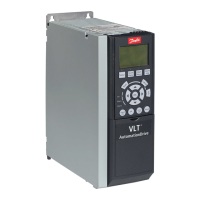





What to do for an inrush fault in Danfoss DC Drives?
If your Danfoss DC Drives are showing an inrush fault, it means too many power-ups have occurred within a short time period. Let the unit cool to operating temperature.
What does a parameter error mean on Danfoss VLT AutomationDrive FC 301 DC Drives?
If your Danfoss DC Drives display a parameter error, it indicates that the parameter is out of range. Set the affected parameter to a valid value.
What causes an external fan fault on Danfoss VLT AutomationDrive FC 301 DC Drives?
If you are experiencing an external fan fault with your Danfoss DC Drives, the fan warning function checks if the fan is running/mounted. Check for proper fan operation. Cycle power to the frequency converter and check that the fan operates briefly at start-up. Also, check the sensors on the heat sink.
How do I fix an internal fan fault on Danfoss VLT AutomationDrive FC 301 DC Drives?
If your Danfoss DC Drives are showing an internal fan fault, the fan warning function is a protective function that checks if the fan is running/mounted. Check for proper fan operation. Cycle power to the frequency converter and check that the fan operates briefly at start-up. Also, check the sensors on the control card.
What to do if Danfoss DC Drives reach a torque limit?
Regarding torque limit issues with Danfoss DC Drives, if the motor torque limit is exceeded during ramp-up, extend the ramp-up time. If the generator torque limit is exceeded during ramp-down, extend the ramp-down time. If torque limit occurs while running, increase the torque limit. Also, check the application for excessive current draw on the motor.
What to do if Danfoss DC Drives show an over current error?
If you are experiencing an over current error with your Danfoss DC Drives, it might be due to shock loading or quick acceleration with high-inertia loads. First, remove the power and check if the motor shaft can be turned. Also, verify that the motor size matches the frequency converter and that the motor data is correctly set in parameters 1-20 to 1-25.
Why is the heat sink temp high on my Danfoss DC Drives?
If your Danfoss DC Drives are reporting a heat sink temperature issue, it means the maximum temperature of the heat sink is exceeded. Check for the following conditions:* The ambient temperature is too high.* The motor cables are too long.* Incorrect airflow clearance above and below the frequency converter.* Blocked airflow around the frequency converter.* Damaged heat sink fan.* Dirty heat sink.
What does control word timeout mean on Danfoss DC Drives?
If you're experiencing a control word timeout with your Danfoss DC Drives, it means there is no communication to the frequency converter. To resolve this, check the connections on the serial communication cable, increase parameter 8-03 Control Word Timeout Time, check the operation of the communication equipment, and verify that proper EMC installation was performed.
How to troubleshoot motor thermistor overtemp in Danfoss VLT AutomationDrive FC 301 DC Drives?
If you are getting a motor thermistor overtemp warning on your Danfoss DC Drives, check whether the thermistor is disconnected. Also, check for motor overheating and if the motor is mechanically overloaded. When using terminal 53 or 54, ensure the thermistor is correctly connected between either terminal 53 or 54 (analog voltage input) and terminal 50 (+10 V supply), and that the terminal switch for 53 or 54 is set for voltage. If using terminal 18, 19, 31, 32, or 33 (digital inputs), ensure the thermistor is correctly connected between the digital input terminal used (digital input PNP only) and terminal 50.
What causes DC under voltage in Danfoss VLT AutomationDrive FC 301?
If you are experiencing a DC under voltage error with your Danfoss DC Drives, check that the supply voltage matches the drive voltage. You may also need to perform an input voltage test and a soft-charge circuit test.
| Category | DC Drives |
|---|---|
| Communication Protocols | CANopen, Profibus, Ethernet/IP, Modbus TCP |
| Cooling Method | Natural convection or forced air |
| Enclosure Rating | IP20 |
| Ambient Temperature | -10 to 45 °C |
| Control Features | PID control |
| Protection Features | Overvoltage, Short circuit |
Summarizes the manual's structure and content.
Lists related technical documents for the FC 300.
Lists the certifications and approvals obtained for the product.
Explains the meaning of graphical symbols used in the manual.
Defines technical abbreviations used throughout the document.
Provides guidance on the proper disposal of the product.
Details hazards and precautions related to high voltage.
Lists general safety regulations and guidelines for safe operation.
Explains risks and prevention methods for unintentional motor start.
Describes the functionality of the protection operating mode.
Provides critical general warnings about electrical hazards.
Details the Safe Stop function and its operation.
Defines key terms related to functional safety standards.
Provides specific installation steps for the Safe Stop function.
Details specific considerations for IT Mains power supply.
Provides an overview of the installation procedures.
Lists items to check before and after unpacking the unit.
Covers mechanical aspects of installing the frequency converter.
Details the physical mounting process of the drive unit.
Describes how to mount the unit through a control panel.
General guidance for electrical installation.
Instructions for wiring unscreened cables for power and control.
Steps for connecting mains power and ensuring proper earthing.
Procedures for correctly connecting the motor to the drive.
Guidance on fuse selection and circuit protection.
Instructions on how to access the control terminal cover.
Detailed steps for connecting control cables to terminals.
Illustrates common wiring configurations.
Example wiring for start/stop control functionality.
Example wiring for pulse start/stop control.
Example wiring for speed adjustment using digital inputs.
Example wiring for analog potentiometer reference input.
Detailed guidance for wiring control cables.
Configuration of DIP switches for input selection.
Steps for performing final setup and testing the drive.
Covers other connection types and functions.
Details on controlling an external mechanical brake.
Instructions for connecting multiple motors in parallel.
Configuration of motor thermal protection settings.
Methods for connecting a PC for control and configuration.
Information on using the PC software for setup.
Overview of the Local Control Panel interfaces.
Programming instructions for the graphical LCP.
Programming instructions for the numerical LCP.
Step-by-step guide for initial setup and configuration.
Basic setup options including language selection.
Procedure for optimizing motor performance via AMA.
Key parameters for basic drive configuration.
Setting the units for motor speed display.
Selecting the torque control method for the motor.
Configuration of motor thermal overload protection.
Selecting the input source for the thermistor sensor.
Configuration options for the brake function.
Parameters for controlling mechanical brakes.
Configuration of digital input functions and assignments.
Configuration of digital output functions and assignments.
Configuration of relay outputs for various functions.
Setting the drive's operating mode (normal, test, initial).
Configuration settings for the RFI filter.
An overview of the parameter organization.
Parameters related to drive operation and display settings.
Parameters for configuring motor and load settings.
Parameters related to the control of brake functions.
Parameters for setting speed references and ramp times.
Parameters for setting operational limits and warnings.
Configuration of digital inputs and outputs.
Configuration of analog inputs and outputs.
Parameters for PID and PI controller settings.
Parameters for communication and option modules.
Parameters specific to Profibus communication.
Parameters specific to CAN Fieldbus communication.
Parameters for Ethernet communication settings.
Parameters for Smart Logic Control functions.
Configuration of special inverter functions.
Information and identification details of the drive.
Parameters used for reading drive data.
Options available for motor feedback configuration.
Additional parameters for reading drive data.
Configuration of advanced special features.
Basic configuration settings for MCO modules.
Advanced configuration settings for MCO modules.
Parameters for reading data from MCO modules.
Configuration options for sensor inputs.
Specifications for the main power supply voltages.
Characteristics of the motor output terminals.
Specifications and configuration of digital inputs.
Specifications and configuration of analog inputs.
Specifications for pulse and encoder input signals.
Specifications and configuration of digital outputs.
Specifications and configuration of analog outputs.
Specifications for the 24V DC output from the control card.
Specifications for the programmable relay outputs.
Environmental conditions required for operation.
Details on electromagnetic compatibility standards.
Lists key protection features and functionalities of the drive.
Explains how warning and alarm messages are indicated and managed.
Addresses warnings related to motor ETR and thermistor over-temperature.
Details alarms for over-current and exceeding torque limits.
Covers alarms related to earth faults and short circuits.
Addresses warnings for brake resistor and chopper faults.
Alarm indicating speed is outside the specified range.
Error during Automatic Motor Adaptation calibration.
Warning for over-temperature of the control card.
Indicates that the Safe Stop function has been activated.
Alarm indicating hardware incompatibility.
Alarm indicating a fault in the brake IGBT module.
Alarm related to heatsink temperature monitoring.
Message indicating a new spare part installation.
Indicates that a new type code has been detected.
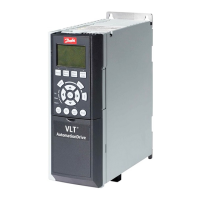
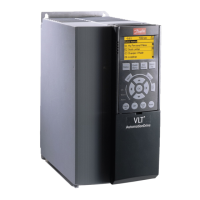
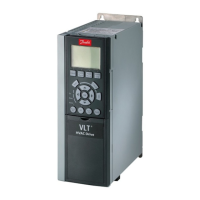

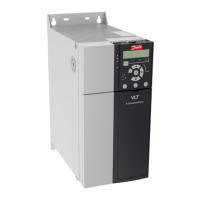
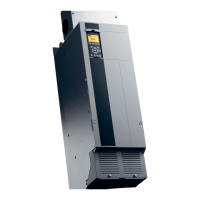


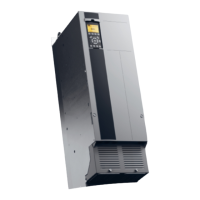
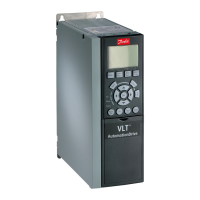
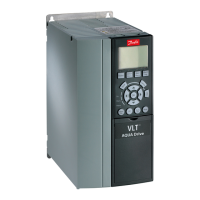
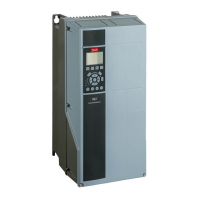
